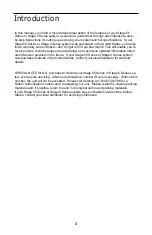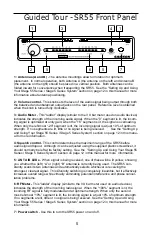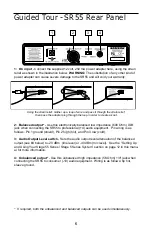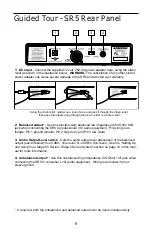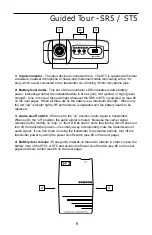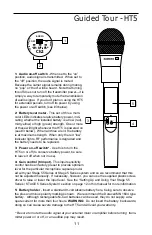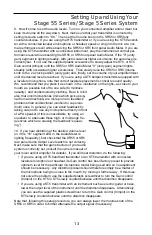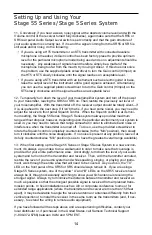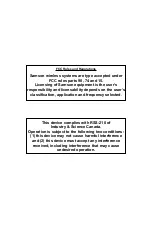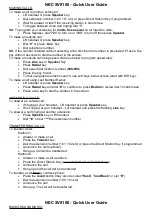
13
Setting Up and Using Your
Stage 55 Series/Stage 5 Series System
9. Now it’s time to set the audio levels. Turn on your connected amplifier and/or mixer but
keep its volume all the way down. Next, make sure that your transmitter is unmuted by
setting its Audio switch to “On.” Then set the Volume knob on the SR55 or SR5 fully
counterclockwise. If you are using the HT5 transmitter or if you are using the ST5 transmit-
ter with a connected lavaliere microphone or headset, speak or sing into the mic at a nor-
mal performance level while observing the SR55 or SR5 front panel Audio Meter. If you are
using the ST5 transmitter with a connected instrument, play the instrument at normal per-
formance level while observing the SR55 or SR5 front panel Audio Meter. If the “0” (unity
gain) segment is lighting steadily, with just occasional higher excursions, the audio level is
correctly set. If not, use the supplied plastic screwdriver to slowly adjust the HT5, or ST5
Gain control (trimpot) until the SR55 or SR5 Audio Meter “0” (unity gain) segment lights
steadily (with occasional higher excursions). Then slowly raise the SR55 or SR5 Volume
knob to the 2 o’clock position (unity gain) and, finally, set the volume of your amplifier/mixer
until the desired level is reached. If you are using a ST5 beltpack transmitter equipped with
a lavaliere microphone, note that correct lavaliere placement is critical to sound quality.
We recommend that you place it as shown in the illustration on the right—as close to your
mouth as possible but off to one side (to minimize
nasality) and unobstructed by clothing. Bear in mind
also that omni microphones (mics which pick up sig-
nal from all directions) are more prone to feedback
problems than unidirectional (cardioid or supercar-
dioid) ones; in general, you can avoid feedback by
taking care not to use any microphone directly in front
of a PA speaker (if this is unavoidable, try using an
equalizer to attenuate those high- or mid-range fre-
quencies which are causing the feedback “squeal-
ing”).
10. If you hear distortion at the desired volume level
(or if the “+6” segment LED in the Audio Meter is
lighting frequently), first check that the SR55 or SR5
rear panel Audio Output Level switch is set correctly.
Next, make sure that the gain structure of your audio
system is correctly set (consult the owners manual of
your mixer and/or amplifier for details). If you still hear distortion, do the following:
• If you are using a HT5 handheld transmitter or an ST5 transmitter with connected
lavaliere microphone or headset, its Gain control has been factory preset to provide
optimum level for the particular microphone model being used and so no adjustment
should be necessary. Any distortion present should therefore simply be a matter of
the microphone being too close to the mouth; try moving it further away. If this does
not solve the problem, use the supplied plastic screwdriver to turn the Gain control
(trimpot) on the HT5 or ST5 slowly counterclockwise until the distortion disappears.
• If you are using a ST5 transmitter with an instrument such as electric guitar or bass,
lower the output level of the instrument until the distortion disappears. Alternatively,
you can use the supplied plastic screwdriver to turn the Gain control (trimpot) on the
ST5 slowly counterclockwise until the distortion disappears.
Note that, following this setup procedure, you can always lower the Volume knob of the
SR55 or SR5 in order to further attenuate the output signal if necessary.




